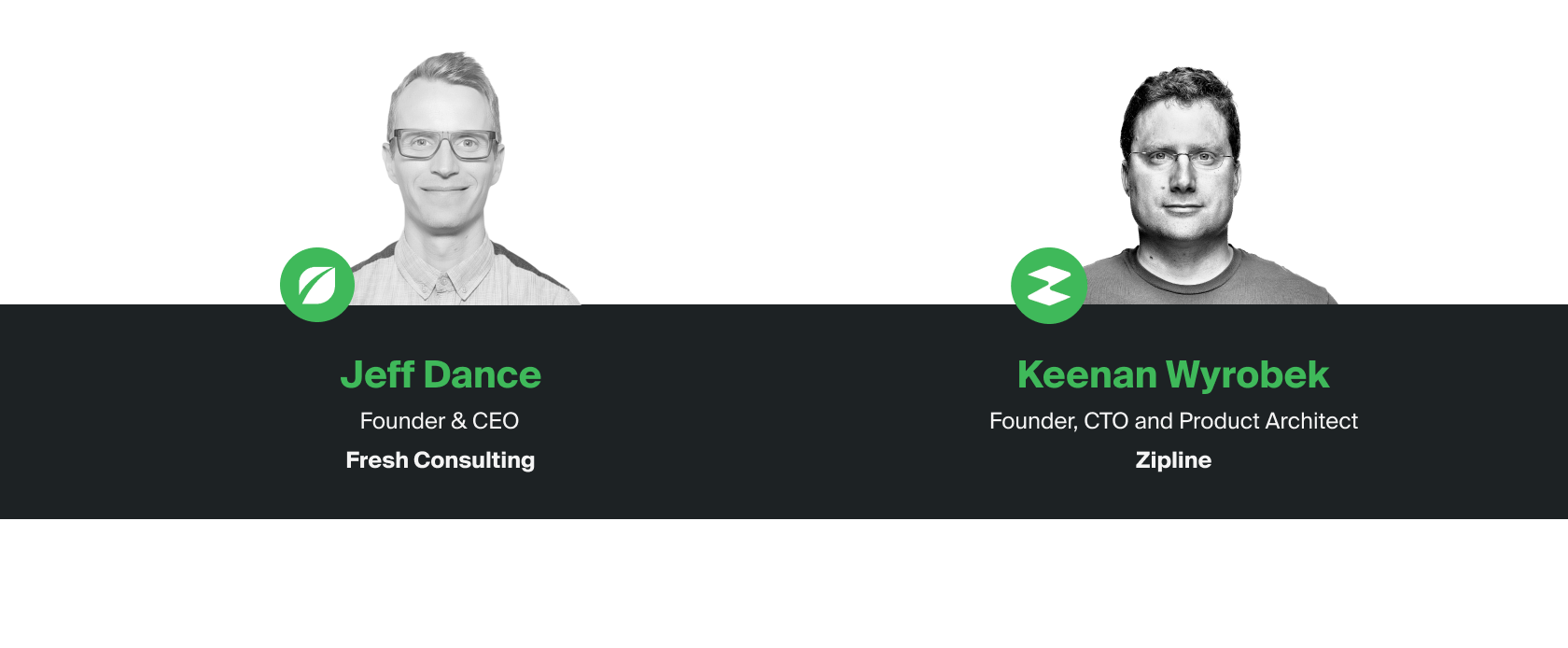The
Future Of Drone Delivery
In this episode of The Future Of, Keenan Wyrobek, Co-Founder, CTO, and Product Architect of Zipline, joins host Jeff Dance to discuss the future of drone delivery. They unveil the current state of the industry, the most recent developments in drone delivery, how Zipline became the market’s leader, and some of the biggest opportunities drone delivery can save and improve lives.
In this episode of The Future Of, Keenan Wyrobek, Co-Founder, CTO, and Product Architect of Zipline, joins host Jeff Dance to discuss the future of drone delivery. They unveil the current state of the industry, the most recent developments in drone delivery, how Zipline became the market’s leader, and some of the biggest opportunities drone delivery can save and improve lives.
In this episode of The Future Of, Keenan Wyrobek, Co-Founder, CTO, and Product Architect of Zipline, joins host Jeff Dance to discuss the future of drone delivery. They unveil the current state of the industry, the most recent developments in drone delivery, how Zipline became the market’s leader, and some of the biggest opportunities drone delivery can save and improve lives

Pioneering Swift and Sustainable Global Delivery Solutions
Zipline stands as the largest autonomous delivery system today, operating in seven countries. The growth has been significant, transforming from a focused blood delivery service to a multi-faceted operation on a national scale. The company recognized the critical need for timely blood delivery, given its short shelf life and consistent demand. Zipline employed its innovative technology to make a substantial impact. This was the company’s primary use case before its expansion into various other domains.
Today, Zipline’s service spectrum has expanded remarkably. Beyond healthcare deliveries of blood, vaccines, and pharmaceuticals to hospitals, clinics, and patient homes, the company’s reach extends to consumer goods, hot food, and good food delivery. They also contribute significantly to animal health in various parts of the world.
Zipline’s model of delivery by air dramatically enhances speed and efficiency. Unlike conventional road transportation, their services don’t depend on traffic, enabling faster deliveries. The ecological footprint is also significantly reduced, marking a staggering 97% reduction in environmental impact compared to traditional delivery methods.
Blending Technological Innovation with Customer Focus
There are essentially two aspects that underscore Zipline’s uniqueness: technology and team culture.
At the technological forefront, Zipline stands out due to its robust and innovative technology stack that consistently delivers excellent performance. One example is its proprietary AI-based “Nowcasting System” – a weather forecasting tool specifically tailored for its drones.
Beyond the technical dimensions, the real essence of Zipline’s distinction lies in its team and organizational culture. The company prioritizes its customers above all else, ensuring that every technical decision aligns with their needs and preferences.
Different Needs, Different Drones
There are various types of drones, and Zipline offers two distinct drone delivery products. Regarding the long-range platform, which the company has been operating for years from a metropolitan area, it serves cities and towns beyond that area. This is a fixed-wing platform, resembling a large RC plane, flying out to a delivery site to drop a package the size of a cake box with a mini parachute attached.
This method is excellent for on-demand long-range delivery, offering unmatched speed and cost-effectiveness compared to other drone technologies or alternatives. However, it requires some space for delivery, which presents a challenge for delivering in metro areas, where space is constrained.
Responding to customers’ demands for more deliveries in metro areas, Zipline developed Platform 2, designed for precise and noiseless deliveries to smaller spaces, like a small veranda or communal areas in apartment buildings. Platform 2 involves a drone that hovers as high as a football field and lowers a smaller drone by a string to the ground. Despite any winds, the droid can navigate precisely to place the package, even on a small table, and then retract, all within seconds and silently.
Transforming the Delivery Landscape
Regarding the current state of the drone delivery industry, the most dominant form of on-demand deliveries today typically involves an individual driving a 3,000-pound vehicle to deliver a small package. This model is economically inefficient, often resulting in delayed and unpredictable deliveries, not to mention its significant environmental footprint.
Zipline is eager to revolutionize this sector. The ambition is to enhance the delivery experience by ensuring timeliness and predictability while significantly mitigating environmental impact. It also aims to provide a much more efficient and reliable alternative to the current vehicular delivery system.
The Impact of Drone Delivery on Our Lives and Professions
Considering the future of drone delivery, envision a scenario 10-20 years from now where your local pharmacy, favorite restaurant, or any nearby place you require is equipped with a special portal on the wall. This portal, quite like the system employed by Zipline, operates like a doorway, allowing drones to slide in and out of buildings without any need to step outside. Orders are loaded onto the drone, and then it departs through this magical portal.
Looking at the professional angle, this advancement holds huge potential. Think about professions that require physical materials.
For instance, consider launching a construction project. The frequency of trips made to the hardware store for forgotten items can be exasperating and time-consuming. The convenience of having the needed products delivered instantly to your location cannot be overstated. The impact on productivity is enormous, and the anticipation to extend this technology across all industries is real and exciting.
Revolutionizing Global Healthcare
The most substantial opportunities for drone delivery lie in its potential to significantly enhance and save lives, particularly within the healthcare sector. Countries worldwide are grappling with a critical dilemma: how to amplify the quality of healthcare while simultaneously diminishing the cost.
New technologies and medications have emerged for various diseases, enhancing healthcare quality but escalating costs. In the United States, a significant portion of the GDP is spent on healthcare, a financial burden that is unsustainable for many countries.
In this context, the prospect of on-demand delivery via drones in the healthcare industry is particularly thrilling. This innovation exceeds emergency situations, offering a robust solution to enhance healthcare quality and reduce costs throughout the entire patient population.
It enables the practical, efficient, and widespread delivery of essential medical supplies, including life-saving medications, directly to people’s homes, supporting commitment to vital treatment regimens and enhancing patient outcomes.



